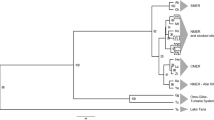Abstract
The genetic make-up of five populations of Oreochromis spp. was examined by microsatellite analysis. Eleven polymorphic microsatellite loci showed significant departures from the Hardy–Weinberg equilibrium. The mean heterozygosity ranged from 0.6280 to 0.7040 for each population. The genetic distance values showed a clear separation between O. niloticus and O. mossambicus. The differentiation of the O. niloticus populations was then tested with various genetic measures, which are based on both the Infinite Allele and the Stepwise Mutation models. All these measures grouped the populations similarly.
Similar content being viewed by others
REFERENCES
Appleyard, S. A. (1998). The Application Of Genetic Markers to Fijian Tilapia Stock Management, PhD thesis, Queensland University of Technology, Brisbane, Queensland, Australia.
Carvalho, G. R., and Hauser, L. (1994). Molecular genetics and the stock concept in fisheries. Rev. Fish Biol. Fish. 4:326–350.
Cavalli-Sforza, L., Menozzi, P., and Piazza, A. (1994). The History and Geography of Human Genes, University Press, Princeton, NJ.
Estoup, A., Garnery, L., Solignac, M., and Cornuet, J. M. (1995). Microsatellite variation in honey bee (Apis mellifera L.) populations: Hierarchical genetic structure and test of the Infinite Allele and Stepwise Mutation Models. Genetics 140:679–695.
FAO (2000). http://www.foa.org/waicent/portal/statistics en.asp Fisheries Statistics The state of Rome. World Fisheries and Aquaculture (1999).
Felsenstein, J. (1993). PHYLIP (Phylogeny Inference Package) version 3.5c. Distributed by the author. Department of Genetics, University of Washington, Seattle.
Goldstein, D. B., Linares, A. R., Sforza, L. L. C., and Feldman, M. W. (1995). An evaluation of genetic distances for use with microsatellite loci. Genetics 139:463–471.
Harvey, B. J. (1986). Gamete banking and applied genetics in aquaculture. In Proceedings of World Symposium on Selection, Hybridization and Genetic Engineering in Aquaculture, Bordeux, Berlin, May 27-30, 1986, Vol. I, pp. 258–263.
Lee, W. J., and Kocher, T. D. (1996). Microsatellite DNA markers for genetic mapping in O. niloticus. Fish Biol. 49:169–171.
Lewis, P. O., and Zaykin, D. (1996). Software for the Analysis of Discrete Genetic Data. Available at http://chee.unm.edu/gda/
Mantel, N. (1967). The detection of disease clustering and a generalized regression approach. Cancer Res. 27:209.
Minch, E., Ruiz-Linares, A., Goldstein, D. B., Feldman, M. W., and Cavalli-Sforza, L. L. (1995). MICROSAT (Version 1.4): A Computer Program for Calculating Various Statistics on Microsatellite Allele Data. Available at www:http://lotka.stanford.edu/research/distance.html
Nei, M. (1973). Analysis of gene diversity in subdivided populations. Proc. Nat. Acad. Sci. U.S.A. 70:3321–3323.
Nei, M. (1978). Estimation of average heterozygosity and genetic distance from a small number of individuals. Genetics 89:583–590.
Nei, M., Tajima, F., and Tateno, Y. (1983). Accuracy of estimated phylogenetic trees from molecular data II. Gene frequency data. J. Mol. Evol. 19:153–170.
Padmaja, K. (1995). Biochemical Polymorphisms in SevenOreochromis Strains of Southeast Asia, Master thesis, Department of Genetics and Cellular Biology, University of Malaya, Kuala Lumpur, Malaysia.
Ruzzante, D. E. (1998). A comparison of several measures of genetic distance and population structure with microsatellite data: Bias and sampling variance. Can. J. Fish. Aquat. Sci. 55:1–14.
Shriver, M. D., Jin, L., Boerwinkble, E., Deka, R., and Ferrell, R. E. (1995). A novel measure of genetic distance for highly polymorphic tandem repeat loci. Mol. Biol. Evol. 12:911–929.
Slatkin, M. (1995). A measure of population subdivision based on microsatellite allele frequencies. Genetics 139:457–462.
Trewavas, E., (1983). Tilapiine Fishes of the Genera Sarotheredon, Oreochromis and Danakilia, British Natural History Museum, London.
Weir, B. S., and Cockerham, C. C. (1984). Estimating F-statistics for the analysis of population structure. Evolution 38:1359–1370.
Wright, S. (1951). The genetic structure of populations. Ann. Eugen. 15:323–354.
Yeh, F. C., Yang, R. C., Boyle, T. B. J., Ye, Z. H., and Mao, J. X. (1997).
Author information
Authors and Affiliations
Rights and permissions
About this article
Cite this article
Bhassu, S., Yusoff, K., Panandam, J.M. et al. The Genetic Structure of Oreochromis spp. (Tilapia) Populations in Malaysia as Revealed by Microsatellite DNA Analysis. Biochem Genet 42, 217–229 (2004). https://doi.org/10.1023/B:BIGI.0000034426.31105.da
Issue Date:
DOI: https://doi.org/10.1023/B:BIGI.0000034426.31105.da




